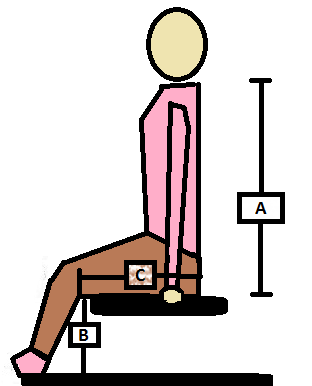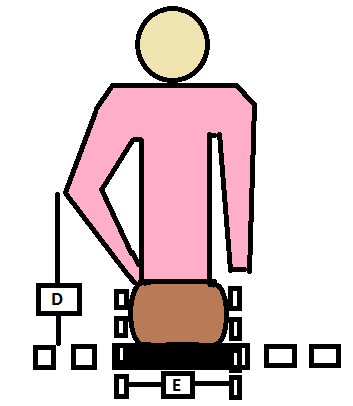Wheelchair Learning Center
Contents
1. Choosing a Wheelchair that is Best for You
2. Measuring for a Perfect Fit
3. Choosing the Features and Customizations of your Wheelchair
What Kind of Wheelchair is best for me?
There are many different factors that will help you to determine what kind of wheelchair will be best for you. Consider your physical abilities and limits, how many hours per day you will occupy the chair, the environment where you will use your wheelchair, if you will be self propelling your wheelchair or pushed by a companion, and your transport and storage needs.
For occasional use for quick and easy transport or to cover long distances quickly, such as in an airport, zoo or mall, a lightweight, compact, easy-fold transport wheelchair pushed by a companion is ideal.
You will need a standard wheelchair with larger rear wheels and hand rims to propel independently.
If you have an active lifestyle and will be on- the-go with your wheelchair for many hours a day, consider a lightweight wheelchair or even an ultra lightweight wheelchair that requires less energy to propel, is easier to maneuver and is simpler to transport by car.
For heavier users, the larger size of a bariatric wheelchair ensures comfort, safety and stability.
A reclining wheelchair provides greater support and more positioning options, and is especially suitable for users who have suffered injuries.
A specialized sport wheelchair supplies maximum speed and agility for wheelchair athletics and sports.
Frequent or long term users (more than two hours per day) should invest in a seat cushion and other accessories for enhanced comfort.
Back to Top
How to Measure for a Wheelchair
A well fitted wheelchair will provide the support you need and the comfort you deserve.


Seat Width- When seated, measure the width of the hips at their widest point. Add one-two inches for movement while seated and to accommodate bulky clothing and coats. (See "E" in diagram above)
Seat widths range from:
- Standard - 17-19 inches,
- Narrow - 15-17 inches,
- Wide - 19-24 inches
- Extra wide - 24-30 inches
Seat Depth - While Seated, measure from the most posterior point of the body to the inside of the knee and subtract two inches. You may want to leave a bit more leg overhang to make room for the hand when lifting the leg. (See "C" in diagram above)
Standard seat depth is 16-18 inches, up to 20 inches for bariatric wheelchairs. Some models offer an adjustable seat rail extension from 16-18”.
Seat to Floor Height - While seated, measure from the back of the knee to the sole of the foot. If you use a seat cushion, subtract the thickness of the cushion (about 2 inches). Then, add at least 2 inches to allow for footrest clearance. If the wheelchair will be foot-propelled, do not add the footrest clearance. (See "B" in diagram above)
The standard seat to floor height for a wheelchair is 18-20 inches. A lower seat to floor height is called hemi-height or ultra-hemi and is suitable for shorter users. Many models feature a dual axle that allows the seat to floor height to be adjusted up to 2 ½ inches. The seat height is usually lower in rear and higher in front for a slight tilt back into the seat.
Back Rest Height - Measure from the base of the chair to the top of the wheelchair back. A higher back rest provides more upper back support, while a lower back rest allows greater freedom for the upper body to rotate. (See "A" in diagram above)
Arm Rest Height- While sitting with both arms bent at a 90 degree angle, measure from the elbow to the seat of the chair to determine the height of the arm rests in relation to the seat. Many wheelchair models offer height adjustable arm rests for a customized fit. (See "D" in diagram above)
Leg Rest Height - While seated, measure from the back of the knee to the sole of the foot to determine the distance between the seat and the footplate. Some leg rests have adjustable rigging for a customized fit.
Back to Top
Choosing the Features and Customizations of my Wheelchair
Explore the wealth of features, options and customizations that will make your wheelchair perfectly suited to your needs at a price that you can afford.
Construction
A wheelchair can be constructed with either a folding frame or a rigid frame. The folding frame wheelchair is built with a cross brace x-frame which folds for easy transport and storage. Its many moving joints allow a bit more flexibility when riding over uneven surfaces, but also suffer greater wear and tear and require more maintenance. The rigid frame wheelchair, constructed with welded joints, provides better stability and is more durable. It is easier to push because of its lighter weight and fewer moving parts. The back of the chair folds down and the wheels have Quick Release Axles so that they can be quickly removed to fit the chair into the trunk of a car.
The wheelchair frame can be constructed from steel, aluminum or titanium. The lighter the weight of the frame, the easier it will be to propel the wheelchair. Standard wheelchairs usually have aluminum frames. Lightweight and ultra lightweight wheelchairs are made of aluminum or titanium. Steel is often used for bariatric wheelchairs to make them especially strong. Remember that in general, the lighter the weight, the more expensive the wheelchair will be.
Upholstery
Nylon upholstery is standard on most wheelchairs. It is breathable, cool and comfortable. Vinyl upholstery is non-stretching and easy to clean. Vinyl is more often found on wheelchairs in institutions that are shared by a large number of users. Tension Adjustable Back Canvas is available on some higher end chairs for maximum control of the seat back tautness.
Check out the many options for Upholstery Colors and Patterns to find a funky, classic or whimsical design that will suit your style. Pediatric wheelchairs offer special colors and patterns for children.
Wheels
Casters- The smaller front wheels of a wheelchair are called casters. The casters stabilize the wheelchair while the rear drive wheels propel it. Standard casters are 6-8 inches in diameter and about 1 inch wide. Larger casters provide a smoother ride over rough terrain, while smaller casters swivel better for smoother turns.
Rear Wheels-The rear wheels of a standard wheelchair are larger, ranging from 20-26 inches in diameter, to allow for self propulsion. The larger the rear wheels, the easier it will be to propel the wheelchair. Wider wheels will roll better over soft terrain like lawns. Composite Mag-style wheels, made of a resilient, lightweight fiber glass-like material are most commonly used today. They are maintenance free. Spoked wheels, similar to the spoked wheels of a bicycle, are used today only by very active users who need exceptional performance. They are stronger and don’t flex when pushed, but they require some maintenance to keep the spokes tight.
Pneumatic, or Air Tires provide the smoothest ride over rough or uneven surfaces and have the best traction, so they are ideal for outdoor use on sidewalks, roads and grass. Since they are softer, they make the wheelchair harder to turn and roll. Air tires need to be refilled periodically and run the risk of flat tires.
Solid and foam filled flat free tires roll and turn very easily, but they provide a more bumpy ride over rough or uneven surfaces. They require very little maintenance and are ideal when the wheelchair will be primarily used indoors.
Semi-Pneumatic or Flat free inserts are air tires with a semi-solid core. They stay harder than an air tire, but ride over rough terrain more smoothly than a solid tire. They often wear out faster and may need to be replaced during the lifetime of the wheelchair.
The Wheel Camber is the angle of the wheel relative to the vertical. More camber improves stability and agility, but it also increases the width of the wheelchair, making it harder to fit through narrow spaces. A standard daily wheelchair uses three degrees of camber. Some specialized sport wheelchairs feature a pronounced negative camber for ultra-responsive motion and effortless turning.
Hand rims are gripped by the user in order to self propel the wheelchair. They can be composite, plastic coated or foam covered.
Wheelchair Brakes, or Rear Wheel Locks, hold the wheelchair in place by exerting pressure on the rear tires to keep them from turning. The brakes are operated either by pulling or pushing a lever. Most wheelchairs can be fitted with an additional brake extension to help the user reach and employ the brake independently.
Armrests
Armrests provide comfort for the arms while seated, aid in independent transfers and assist in weight shifting.
Full Length Armrests (15 inches long) extend from the wheelchair back until the front of the seat. They provide full support for the user’s arms and aid in independent transfers in and out of the wheelchair. A full length arm can be fitted with a full or hemi wheelchair tray.
The shorter Desk Length Armrests (11 inches long) provide support from the wheelchair back to three quarters of the seat. They permit the user to comfortably sit near a table or work at a desk. Desk length arms are too far back to aid in independent transfers in and out of the wheelchair.
Removable Armrests can be unattached from the frame of the wheelchair to allow for a sliding transfer into the wheelchair, and to reduce the weight of the chair for transport.
Flip Back or Swing Away Armrests can flip to the back or swing to the side of the wheelchair for easier transfer in and out of the wheelchair.
Adjustable Height Armrests can be adjusted so that they are not too high or to low for the user’s arms. Arm rests that are just the right height provide comfort and support and promote good posture. Full length adjustable height arm rests can be quickly lowered to fit under a table or desk.
Leg Rests
Leg rests support the feet and legs of the wheelchair user.
Swing Away Detachable Leg Rests swing to the side to make transfers easier. They can be detached from the frame of the wheelchair.
Elevating Leg Rests allow the user to elevate the legs to any angle for optimal comfort. Each leg can be elevated independently. Elevating leg rests are required for a reclining wheelchair, but are usually avoided on a lightweight wheelchair since they increase the total weight of the wheelchair.
Some leg rests hangers have Adjustable Rigging that can adjust the height between the seat and the foot plate from 14-18 inches.
Standard Footplates are made of aluminum or plastic and generally support the foot from the heel until the ball of the foot. Adjustable angle footplates are longer to support more of the foot and can be angled front to back and side to side for the user’s comfort. Many bariatric wheelchair models feature Extra Heavy Duty Footplates that can support the greater weight of the foot.
Some leg rests include Calf Straps or Heel Loops for safety and comfort.
Rigid wheelchairs and sport wheelchairs that are built for performance usually have no leg rests at all; they have a fixed front end with an angle adjustable Foot Board incorporated into the design of the frame.